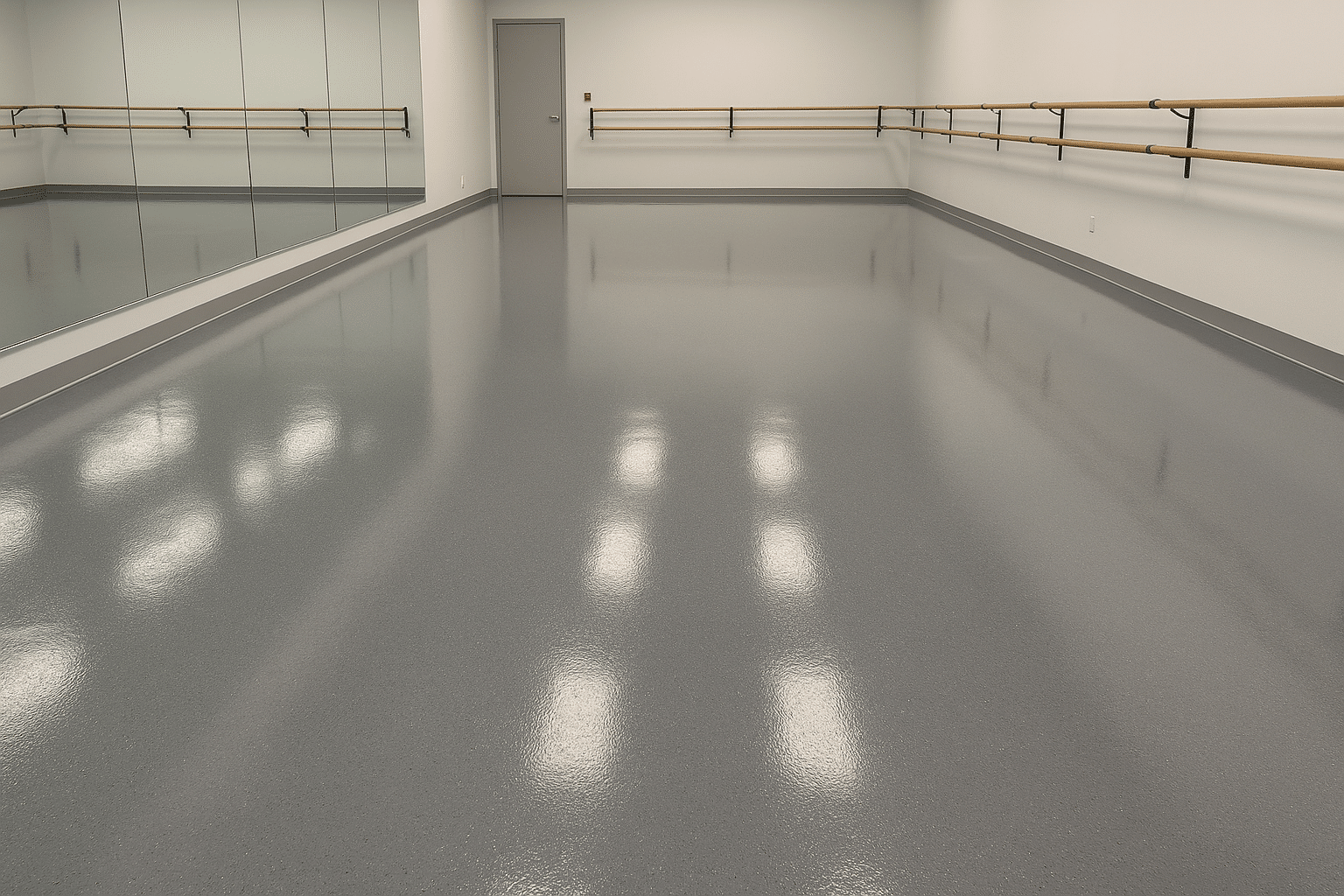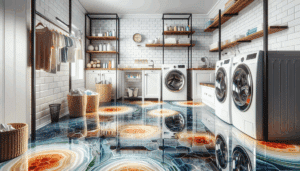Thinking about making your dance space safer, more beautiful, and just plain more fun to rehearse in? You’re in the right place. Whether you teach ballet in a Salt Lake City studio, run a community center with Zumba classes, or you’re a homeowner adding a home practice room in the Avenues—Epoxy Floor coating can change how the space feels, sounds, and performs. Let me explain what it does, why folks here in Salt Lake City like it, and how Utah Epoxy Coatings can help you get there without turning your studio into a construction site for weeks.
Contents
- 1 Why dancers and studio owners are talking about epoxy (and why you should, too)
- 2 What types of epoxy work best for dance spaces?
- 3 Surface prep: the part nobody wants to think about, but it’s crucial
- 4 Performance matters: grip, cushion, acoustics, and acoustics again
- 5 Design, color, and mood—because studio vibe matters
- 6 Maintenance: easy, honest, and mostly boring (in a good way)
- 7 Costs and return—what it means for homeowners vs. businesses
- 8 Local things to think about—Salt Lake City factors
- 9 Common questions people actually ask
- 10 Thinking about logistics? Here’s how the Process typically flows
- 11 Ready to talk specifics? We can help you choose the right feel and finish
- 12 Get in touch — let’s make your dance space feel like home
Why dancers and studio owners are talking about epoxy (and why you should, too)
At first glance epoxy seems like a very hard, kind of industrial thing. But here’s the thing: the right epoxy for dance is engineered to be performance-friendly. It’s durable, easy to clean, and it reflects light in a way that brightens the room—great for evening rehearsals when you want clear sightlines.
Honestly, dancers notice subtle differences: a slight give underfoot, consistent grip, fewer stray splinters from old wood floors. Those little things add up—fewer slips, fewer bruises, and more confidence during turns and leaps. For studio owners, there’s the bonus of low maintenance and resistance to shoe scuffs and spilled water bottles. Sounds boring, but it matters.
What types of epoxy work best for dance spaces?
Not all epoxies are created equal. You might hear industry names like “100% solids epoxy,” “urethane topcoat,” or “Flake systems”—they mean different things for feel and performance. Here’s a quick table to help:
| Solid #ddd;”>Type | How it performs | Best for |
|---|---|---|
| Epoxy with urethane topcoat | Tough, UV-resistant gloss; adjustable slip resistance | Studios wanting durability + aesthetics |
| Flake systems | Textured surface, hides imperfections | Community centers, multipurpose rooms |
| High-build epoxy | Thicker layer; better for minor unevenness | Older floors with repairs |
See? Practical choices. A urethane topcoat, for example, reduces yellowing under studio lights—great for photos and performances. Flake systems are forgiving and hide scuffs; they do slightly change the texture though, so if you want a super slick surface for certain dance styles, talk to us first.
Surface prep: the part nobody wants to think about, but it’s crucial
Let’s be honest: the magic is mostly in the prep. A shiny epoxy on a poorly prepared concrete slab will peel faster than a bad pun. We grind, repair, and level the substrate. That might mean patching cracks, removing old coatings, or adding a moisture barrier if the slab is doing weird things—Salt Lake basements and garages can carry moisture surprises after snowmelt.
Timeline? For a typical studio room you’re looking at 2–4 days for prep and coating, maybe longer if serious repairs are needed. The floor needs time to cure—walk-on after 24–48 hours, regular use after about a week for most systems. Patience pays off. Trust me.
Performance matters: grip, cushion, acoustics, and acoustics again
Dance folks care about four things: grip (so they don’t slip), give (so knees and joints are happy), consistency (you want the same feel across the room), and sound (no echo chamber unless that’s the vibe). Epoxy can be tailored for all of those—by adding a finely tuned surface additive for grip, using a shock-absorbing sublayer, or selecting a finish that dampens noise.
Yes, epoxy is hard. But with the right underlayment or floating subfloor, you can get surprising resilience. Mild contradiction there—you may think “epoxy = rock-hard,” but layered systems exist so the floor can be firm and forgiving at once. Like a well-tuned barre: firm, but responsive.
Design, color, and mood—because studio vibe matters
Color choice isn’t just cosmetic. Lighter floors bounce light and can make a small studio feel larger. Darker tones are cozier and hide scuffs. Metallic epoxy patterns create depth and a modern stage-like feel. You can add colored zones or markings—very useful for classes that use spots or for choreography rehearsals.
You know what? Some of our clients put down subtle gridlines for social dance classes—north, south, center—and it helps with spacing. Others prefer glossy champagne tones because they photograph beautifully for social media. Whatever your taste, epoxy gives options—from satin Finishes that reduce glare to high gloss that dazzles.
Maintenance: easy, honest, and mostly boring (in a good way)
One of the quiet joys of an epoxy floor: cleaning is simple. Sweep, mop with a neutral pH cleaner, and occasional buffing keeps the surface looking new. No waxing. No sanding every season. That saves time and money—especially for busy studios with back-to-back classes.
If you’re worried about repairs, small gouges can be patched professionally without full replacement. For heavy studios, a maintenance plan—annual inspection and a recoat every 5–7 years—keeps things in peak shape.
Costs and return—what it means for homeowners vs. businesses
Cost varies by system, room size, and prep. Home practice rooms might be less expensive per square foot because traffic is lighter and expectations differ. Commercial studios need higher-grade products and possibly impact-attenuating subfloors. Still, the long lifespan and low upkeep often mean epoxy pays for itself compared with repeated wood floor repairs or replacement.
Think of it this way: you pay once for a floor that gets used every day. That’s an investment in safety, aesthetics, and the experience your dancers have every single class. And in Salt Lake City—where you’re competing for students and attention—appearance and durability matter.
Local things to think about—Salt Lake City factors
Living and working in SLC comes with seasons. Winter salt on shoes, spring humidity shifts, and the occasional dust storm in late summer—these are small nuisances, but they affect floors. We recommend a slightly tougher topcoat and a tight seal in areas where outdoor shoes might track grit inside. Also, if your studio has large windows with afternoon sun from the Wasatch slopes, pick UV-stable coatings to prevent yellowing.
Community programs and school dance departments will love epoxies for their low maintenance and long life, while boutique studios will appreciate the design flexibility. Each use case has its own priorities, and we tailor the solution accordingly.
Common questions people actually ask
Will epoxy make the floor too slippery? Not if you don’t want it to. We can add subtle texture or anti-slip additives to match dance styles—ballet, tap, hip-hop—each needs different grip levels.
Can I install over an existing floor? Sometimes. Concrete is ideal; other substrates need testing. Old coatings might require stripping. We always assess before quoting.
How long does it really last? With proper prep and a quality topcoat, 10+ years is realistic for many commercial Applications. Home settings often last even longer.
Thinking about logistics? Here’s how the Process typically flows
Quick version: site visit and assessment, prep (grind/repair), primer, base epoxy, optional decorative layer, topcoat, cure. Each step has a purpose and we explain it plainly—no jargon without context. You’ll get a timeline and a cleanup plan, and yes, we’ll work around class schedules when possible.
Ready to talk specifics? We can help you choose the right feel and finish
You don’t have to commit to a whole studio floor the first time. Many clients start with a rehearsal room or a reception area and expand later. We’ll bring samples, show you finishes under your studio lighting, and discuss impact options for dancers’ knees and joints. We’re practical, direct, and kind of picky about doing the job right.
Get in touch — let’s make your dance space feel like home
If you’re in Salt Lake City and curious how epoxy floor coating can improve your studio, home practice room, or community space, call us. Seriously—call. We’ll answer questions, schedule a quick site visit, and give you a clear Estimate.
At Utah Epoxy Coatings we blend practical know-how with a genuine love for spaces where people move and create. Want a floor that performs as hard as your students do? Reach out and let’s talk.




